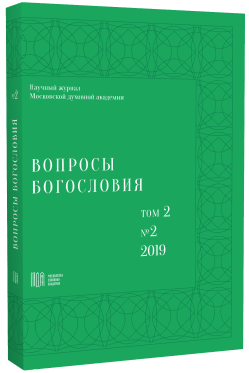Fr. Pavel Florensky on Antinomies
DOI:
https://doi.org/10.31802/2658-7491-2019-2-2-38-58Keywords:
antinomy, antinomic method, Priest Pavel Florensky, Hegumen Andronik Trubachev, contradiction, apocatastasisAbstract
The article explains the concept of antinomy; it is specified that religious antinomies most convincingly characterize the antinomy of truth. The distinction between antinomy and related concepts is illustrated by the concept of sin, as well as the characters in the novel by F. M. Dostoevsky. The assertion of antinomy of truth is central to the philosophy of Fr. PavelFlorensky. In his book “The Pillar and the Ground of the Truth”, he places a table of doctrinal antinomies accompanied by a theological commentary in three aspects: gnoseological, ontological and apologetic. Those are eleven antinomies from various fields of theology: trinitarian, christological, anthropological and eschatological. Special attention is paid to the question of eternity and reality of torment in hell the antinomy of Gehenna. No sooner had Florensky departed from the antinomy of possibility and impossibility of eternal torment, which he had voiced before, that there arrived a theologically questionable idea of division of personality into an image of God in man and a character of man himself (a “self” to be saved and a “selfishness” to be thrown to Gehenna; the substance of the soul naturally ought to refer to the “self” and is therefore unconditionally saved). Florensky herewith involuntarily confirms the truth of the antinomic method, which he is to use in his subsequent works. “The Pillar and the Ground of the Truth” reveals that for Florensky the antinomy is something more than a cognitive tool. It rather embodies an ontological principle. Although in the “Pillar” the author describes it as “suffocating” (unbearable for consciousness), in “The Philosophy of Cult” it becomes “alive” (a sign of the vitality of the phenomenon). The proposed commentary on Florensky’s book is intended to clarify the concept and the meaning of antinomy by providing religious examples.
Downloads
References
Толковая Библия, или комментарии на все книги Св. Писания Ветхого и Нового Завета / под ред. А. П. Лопухина. Т. II. Новый Завет. М., 2006.
Андроник (Трубачев), игумен. Путь к Богу. Личность, жизнь и творчество священника Павла Флоренского. Кн. 3. Сергиев Посад, 2015.
Григорий Богослов, свт., архиеп Константинопольский. Творения: в 2 т. Т. I: Слова. М., 2010.
Игнатий Брянчанинов, свт. Отечник. Собрание сочинений. Т. 6. М., 2011.
Иосиф Исихаст, старец. Изложение монашеского опыта. Троице-Сергиева Лавра, 2006.
Казарян А. Т. Антиномия // Православная энциклопедия. М., 2001. Т. 2.
Трубецкой Е. Н. Свет Фаворский и преображение ума // Флоренский П. А.: pro et contra. СПб, 1996.
Флоренский Павел, свящ. Сочинения: в 4 т. Т. 2. М., 1996.
Флоренский Павел, свящ. Столп и утверждение истины. Опыт православной теодицеи в двенадцати письмах. М., 2017.
Groth Bernd, Dr. Philosoph und Theologe in dunkler Zeit. Grundzüge des religionsphilosophischen Denkens von Pavel Florenskij. URL: https://www.akademie-rs.de/fileadmin/user_upload/ download_archive/religion-oeffentlichkeit/150803_groth_florenskij.pdf.
Downloads
Published
How to Cite
License

This work is licensed under a Creative Commons Attribution-ShareAlike 4.0 International License.







